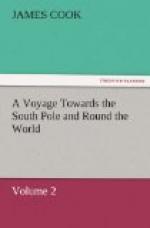Fresh provisions for present use may be got, such as beef, vegetables, and fruit; and hogs, sheep, and poultry for sea stock, all at a pretty reasonable price; but I do not know that any sea-provisions are to be had, except wine. The bullocks and hogs are very good, but the sheep are small and wretchedly poor.
The principal produce of Fayal is wheat and Indian corn, with which they supply Pico and some of the other isles. The chief town is called Villa de Horta. It is situated in the bottom of the bay, close to the edge of the sea, and is defended by two castles, one at each end of the town, and a wall of stone-work, extending along the sea-shore from the one to the other. But these works are suffered to go to decay, and serve more for shew than strength. They heighten the prospect of the city, which makes a fine appearance from the road; but, if we except the Jesuits’ college, the monasteries and churches, there is not another building that has any thing to recommend it, either outside or in. There is not a glass window in the place, except what are in the churches, and in a country-house which lately belonged to the English consul; all the others being latticed, which, to an Englishman, makes them look like prisons.
This little city, like all others belonging to the Portuguese, is crowded with religious buildings, there being no less than three convents of men and two of women, and eight churches, including those belonging to the convents, and the one in the Jesuits’ college. This college is a fine structure, and is situated on an elevation in the pleasantest part of the city. Since the expulsion of that order, it has been suffered to go to decay, and will probably, in a few years, be no better than a heap of ruins.
Fayal, although the most noted for wines, does not raise sufficient for its own consumption. This article is raised on Pico, where there is no road for shipping; but being brought to De Horta, and from thence shipped abroad, chiefly to America, it has acquired the name of Fayal Wine.
The bay, or road of Fayal, is situated at the east end of the isle, before the Villa de Horta, and facing the west end of Pico. It is two miles broad, and three quarters of a mile deep, and hath a semi-circular form. The depth of water is from twenty to ten and even six fathoms, a sandy bottom, except near the shore, and particularly near the S.W. head, off which the bottom is rocky, also without the line which joins the two points of the bay, so that it is not safe to anchor far out. The bearing before mentioned, taken when at anchor, will direct any one to the best ground. It is by no means a bad road, but the winds most to be apprehended, are those which blow from between the S.S.W. and S.E.; the former is not so dangerous as the latter, because, with it, you can always get to sea. Besides this road, there is a small cove round the S.W. point, called Porto Pierre, in which, I am told, a ship or two may lie in tolerable safety, and where they sometimes heave small vessels down.




